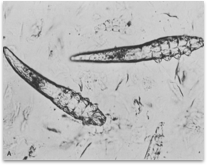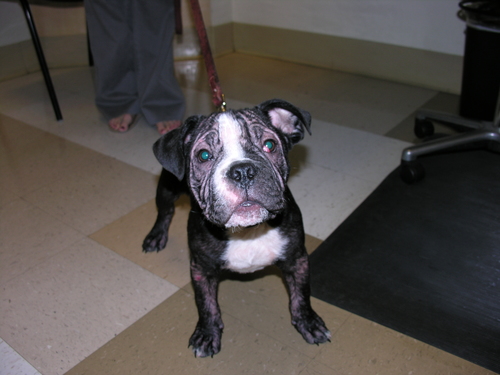Does my dog have mange?

When a dog has little tiny mites causing hairloss or itchiness, this condition is often referred to as “mange.”
There are two main kinds of mange that we see in dogs, and distinguishing the type of mange is important, because one type is contagious to other dogs and people, and the other is not!
When the Demodex mite causes mange, it is often called Puppy Mange. Why? You guess it! Because it is usually seen in puppies or occasionally in immune suppressed animals (such as dogs that have a severe allergy problem in their skin.)
PUPPY MANGE (DEMODEX) TYPICALLY CAUSES:
-
HAIR LOSS AROUND THE EYES, LIPS AND FEET
-
ISN’T VERY ITCHY
-
PATCH HAIR LOSS ALONG THE SIDES OF THE BODY
-
OFTEN RESULTS IN CRUSTY, THICK AND STINKY SKIN
 Here is a picture of two demodex mites under the microscope. They are so small that they can fit inside a hair follicle! The adult Demodex mite has eight little legs and a “cigar shaped” body.
Here is a picture of two demodex mites under the microscope. They are so small that they can fit inside a hair follicle! The adult Demodex mite has eight little legs and a “cigar shaped” body.
 When these mights cause mange, it’s called “Demodectic Mange.” There are numerous treatments for this type of infestation and it can take several months to resolve. The long time course for treatment is in part because 1) the patient has a lowered immune system and 2) the secondary skin infection can be a real challenge to bring under control.
When these mights cause mange, it’s called “Demodectic Mange.” There are numerous treatments for this type of infestation and it can take several months to resolve. The long time course for treatment is in part because 1) the patient has a lowered immune system and 2) the secondary skin infection can be a real challenge to bring under control.
While there are some over-the-counter remedies for this type of mange, many of them are too toxic to be safe for puppies. Remember:& Our goal is to poison the mite without poisoning the patient. OTC products don’t provide the same safety guarantees as the products your veterinarian has in the clinic pharmacy!
Scabies is the other type of mange. The Scabies mite is constantly biting the dog (to feed) and this causes intense irritation and itchiness.
SARCOPTIC (OR SCABIES) MANGE TYPICALLY CAUSES:
-
INTENSE ITCHINESS— OFTEN TO THE POINT WHERE THE DOG IS DOING NOTHING BUT CHEWING ON HIMSELF AND SCRATCHING.
-
HAIR LOSS STARTING ON THE LEGS AND WORKING ITS WAY UP THE SIDES OF THE BODY.
-
RED BUMPS WHEREVER THERE IS HAIR LOSS.
These mites are intensely contagious, and will bite people, too. Most people who get scabies from their dog will note increased itchiness and a pimple-like rash on their bellies.
The good news about Sarcoptic Mange is that these mites tend to be quick to control. Usually within a couple of days of the first treatment owners note a marked decrease in their dog’s chewing behavior.
Your veterinarian has a number of safe and effective products for bringing a Sarcoptic Mange problem under control quickly— hopefully before it spreads to other animals (or people!). Also, the veterinarian can help your pet with any secondary skin infections or other issues that the mites caused with all their mischief!
If the above problems don’t sound like your dog’s issue— then it is time to see your pet’s Doctor! Your dog may have allergies, a hormone imbalance, skin infection, vitamin deficiency or a number of other issues that can cause some combination of smelly skin, baldness, itchiness and more.
Article written by Dr. Jon Klingborg, DVM
Please feel free to distribute this article (at no charge) via all media— all we ask is that you give credit to the author Dr. Jon Klingborg. You will find him at the best veterinary hospital in Merced, California– Valley Animal Hospital. www.vahmerced.com and www.valleyanimalmerced.com Copyright 2015 by Jon Klingborg, DVM
